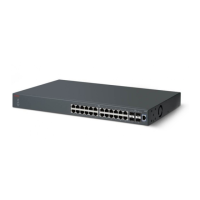Name Description
InMulticastPkts Displays the number of packets delivered by
this sublayer to a higher sublayer that were
addressed to a multicast address at this
sublayer. For a MAC layer protocol, this
number includes both group and functional
addresses.
OutMulticastPkts Displays the number of packets that higher-
level protocols requested be transmitted,
and that are addressed to a multicast
address at this sublayer, including those that
were discarded or not sent. For a MAC layer
protocol, this number includes both group
and functional addresses.
InBroadcastPkts Displays the number of packets delivered by
this sublayer to a higher sublayer that are
addressed to a broadcast address at this
sublayer.
OutBroadcastPkts Displays the number of packets that higher-
level protocols requested be transmitted,
and that were addressed to a broadcast
address at this sublayer, including those that
were discarded or not sent.
InDiscards Displays the number of inbound packets
chosen to be discarded even though no
errors were detected to prevent their being
deliverable to a higher-layer protocol. One
possible reason for discarding such a packet
can be to free up buffer space.
OutDiscards Displays the number of outbound packets
chosen to be discarded even though no
errors were detected to prevent them from
being transmitted. One possible reason for
discarding such a packet can be to free up
buffer space.
InErrors For packet-oriented interfaces, the number
of inbound packets that contained errors
preventing them from being deliverable to a
higher-layer protocol. For character-oriented
or fixed-length interfaces, the number of
inbound transmission units that contained
errors preventing them from being
deliverable to a higher-layer protocol.
OutErrors For packet-oriented interfaces, the number
of outbound packets that cannot be
transmitted because of errors. For character-
Network monitoring configuration using Enterprise Device Manager
64 Configuration — System Monitoring March 2013
Comments? infodev@avaya.com

